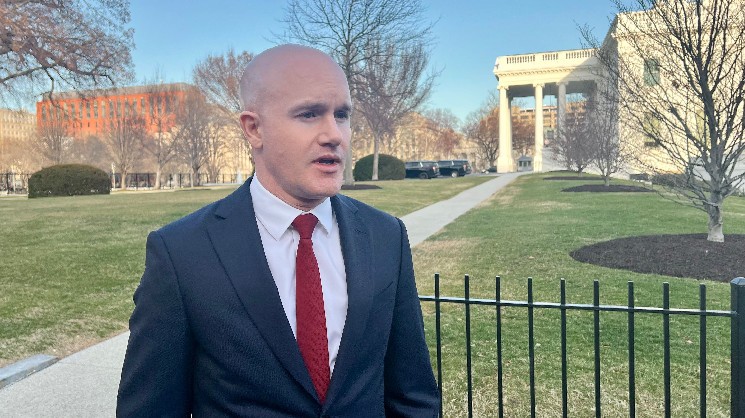Ethereum’s latest update could make DeFi protocol feel like normal apps, and boost ETH in the long run, says P2P.org’s executive.
For the past year, Ethereum (ETH) has been steadily losing dominance to other altcoins, as well as Bitcoin. Layer 2 networks are eating into Ethereum’s revenue, causing some traders to question the network’s evolving tokenomics.
Rather than give in to the pressure, the Ethereum Foundation has doubled down, launching a new update focused entirely on usability and scalability. Artemiy Parshakov, Vice President of Institutions at staking infrastructure provider P2P.org, explained to crypto.news why this is the correct approach.
Instead of prioritizing short-term revenue, the upcoming Pectra upgrade aims to make decentralized apps more user-friendly, introduce new features to the network, and help Ethereum reinforce its leadership in the DeFi space.
Read more: Pectra upgrade could flip sentiment for Ethereum: MEXC COO
crypto.news: What are the most consequential changes that the Pectra upgrade brings to Ethereum?
Artemiy Parshakov: The Pectra upgrade is honestly a game-changer for Ethereum staking. The most radical shift is moving from the rigid 32 ETH validator limit to allowing up to 2048 ETH per validator. This completely transforms the economics for operators like us.
We’re also excited about auto-compounding. Instead of rewards just sitting there, they’ll now automatically feed back into your validator, growing your stake over time. Our models show this could bump returns from 3.2% to around 3.4% over five years – doesn’t sound huge, but that’s an extra ETH per validator at current prices.
You might also like: Pectra upgrade could flip sentiment for Ethereum: MEXC COO
Another big win is the slashing penalty reduction. The initial penalty is dropping by 128x, from 1 ETH to about 0.008 ETH per 32 ETH staked. This makes staking dramatically safer without compromising network security. For more conservative clients who’ve been hesitant to stake, this removes a major barrier.
And finally, partial withdrawals mean you’re not locked in completely. You can pull some ETH while keeping your validator running – much more flexible than the all-or-nothing approach we’ve had until now.
CN: The Pectra upgrade is focused on account abstraction, with specific upgrades to transaction batching, gas sponsorship and authentication. What are some of the innovations on the dApp front that this may enable?
AP: Account abstraction opens up possibilities that were simply impossible before. The ability to delegate control from standard accounts to smart contracts means we can finally build DeFi and staking products that feel like normal apps.
The gas sponsorship aspect is huge. Think about onboarding new users to staking – they’ve always needed ETH just to pay for transactions. Now, validators can sponsor those gas fees, removing that initial friction completely. Users can essentially interact with Ethereum without directly holding ETH for gas.
You might also like: What is Gwei and why it matters for Ethereum users
We’re already working on practical applications at P2P.org. One feature in our R&D pipeline automatically calculates ideal withdrawal timing based on network conditions. Before Pectra, this would require manual intervention, but now we can build systems that execute these withdrawals automatically when the timing is perfect.
We’re also exploring cross-protocol interoperability – imagine seamlessly moving your staked assets between protocols like SSV, EigenLayer, and Swell to optimize returns. Account abstraction makes these complex interactions much more streamlined.
CN: How does raising the maximum effective validator balance from 32 ETH to 2048 ETH impact P2P.org’s operations related to validators?
AP: This change is transformative for our operational approach. A single 640 ETH validator will generate the same rewards as twenty separate 32 ETH validators.
We’ve been preparing for this for months, testing extensively to ensure we’re ready on day one. Our approach is to strategically cap validator balances at 1,920 ETH rather than the full 2,048 ETH. This gives us a two-year runway before hitting the limit where auto-compounding would stop – ensuring uninterrupted compounding benefits for our users.
The operational savings aren’t just good for our bottom line – they allow us to offer better rates to clients. We’re already working on ways to pass these efficiency gains back to stakers through higher rewards.
CN: Do you foresee the potential for centralization risk from increasing validator balance?
AP: This is a question we’ve thought about extensively. The design is actually quite elegant – larger validators maintain the standard attestation frequency but their votes carry proportionally greater weight. So a 2048 ETH validator has the same influence as 64 individual validators, preserving the security model.
The interesting aspect is that Pectra might actually encourage more decentralization. Currently, there’s a significant barrier to entry with the technical complexity of running many validators. By allowing consolidation, smaller operators can compete more effectively on efficiency rather than scale.
CN: Ethereum is trending toward making transactions cheaper, especially by leveraging L2s. However, this appears to be hurting its revenue in the short term. What is your perspective on the long-term effects of this trend, and should Ethereum focus more on generating revenue in the short term?
AP: Ethereum’s approach here shows real strategic vision rather than chasing quarterly results. Making transactions more affordable through L2s and efficiency improvements is building a more sustainable ecosystem for the long run.
The history of technology shows that platforms prioritizing affordability and accessibility eventually win the market. Look at how AWS democratized cloud computing or how cheaper smartphones drove mobile adoption globally.
You might also like: ‘Make me feel emotional desire to quit:’ Ethereum’s Buterin frustrated by community’s focus on ‘degen casino’
With Pectra specifically, the protocol is becoming more efficient from a cost perspective while actually improving the economics for stakers through features like auto-compounding. This balances the needs of users and validators in a way that strengthens the entire ecosystem.
We see these changes as part of Ethereum’s natural evolution. Our focus at P2P.org has always been on performance optimization – we’re currently ranked #1 for validator effectiveness among major operators. These protocol improvements allow us to push that performance even further while making staking more accessible to everyone.
The innovations around flexible fee structures and account abstraction will likely drive more users to the network, creating a larger pie for everyone rather than optimizing for short-term fees.
Read more: Ethereum’s stablecoin market cap jumps 1m-fold since the first time ETH reached $1,4k














Leave a Reply